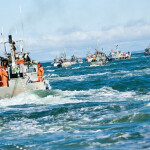Covering the seafood industry is never dull, with so much media, government and science-community attention on the industry and the oceans we all depend on. As another year wraps up, let’s take a quick look at my subjective list of the top 10 seafood stories of 2011 for North America.
10) Demand for shark fins may only be strong in China, where shark fin soup is considered a status-symbol delicacy, but the practice of finning sharks and then dumping their bodies at sea might be the most despicable act occurring at sea. What a cruel, disrespectful waste. In the conservation world, it was the year of the shark. The Shark Conservation Act strengthened a law banning the practice in U.S. waters, and other nations around the world are adopting restrictions as well. Except for Papua New Guinea, that is. Yao Ming, your work is not done.
9) Sticking with at-sea issues, the Obama administration recently introduced legislation that would prevent vessels engaging in illegal, unreported and unregulated (IUU) fishing from entering U.S. ports to offload their catch. The Pirate Fishing Elimination Act needs to advance quickly, as does the treaty Obama submitted to the Senate in November, the Agreement on Port State Measures to Prevent, Deter and Eliminate [IUU] Fishing. Pirate fishing deprives law-abiding fishermen up to USD 23.5 billion a year in revenue. All port nations should ratify this treaty, and none too soon.
8) President Obama also signed the Food Safety Modernization Act (FSMA) into law, enacting preventative measures at the source of food production and giving more enforcement power to authorities in top food agencies. It’s been said before, but you can’t inspect your way to a safe seafood supply. A risk-based approach like the FSMA is a smarter method, considering that imports dominate the U.S. seafood supply. Canadian and U.S. agencies are teaming up on food-safety initiatives, and that’s a good thing for these important trading partners.
7) Genetically modified (GM) farmed salmon (the No. 3-ranked story on last year’s list) faces more obstacles before the technology developed by AquaBounty Technologies of Waltham, Mass., produces market-ready fish. Purdue University animal-sciences professor William Muir said earlier this year that not approving GM salmon for human consumption “may set back efforts to increase food production.” Dr. Stephen Newman also said as much, albeit in much stronger language, in a recent SeafoodSource blog. Others in the environmental and fishing communities are, to be kind, a lot more skeptical. Wherever you stand on this issue, you have to admit the role of science in food production only figures to increase.
6) The National Oceanic and Atmospheric Administration says it is making great progress in ending overfishing. To wit, 21 fisheries nationwide have been rebuilt to healthy levels since 2000, thanks in part to some unpopular harvest restrictions. “We are turning a corner as we see important fish stocks rebounding,” said Eric Schwaab, assistant administrator for NOAA Fisheries, which reported that 84 percent of the stocks the agency examined for fishing activity were free from overfishing. Hopefully, a solution can be found to secure fragile Gulf of Maine cod stocks for the future.
5) What a stretch for Tilman Fertitta. The CEO of Landry’s Restaurants also had a big year in 2010, when his Houston-based casual dining, hospitality, gaming and entertainment company became privately owned after two years of often-contentious negotiations with shareholders. He followed that deal by scooping up Claim Jumper, Bubba Gump Shrimp Co. and The Oceanaire Seafood Room. Near the end of a feature for the January issue of SeaFood Business, Top Gun, I posed this question: “Will Fertitta, the self-proclaimed ‘deal junkie,’ buy yet another well-known restaurant chain in the future?” We got an answer in November, when Landry’s bought Portland, Ore.-based restaurant chain McCormick & Schmick’s for USD 131.6 million, a deal that set off numerous investigations from law firms contending that M&S did not get full value for its shareholders. Fertitta wasn’t done scooping up properties: In December, he picked up Morton’s Restaurant Group for USD 116.6 million, extending his empire to Hong Kong. This is good restaurant news.
4) The No. 4 news story of 2011 might not be fully resolved by the end of 2012 by the looks of things. If proven to be true, the presence of infectious salmon anemia (ISA) in western Canadian salmon — wild or farmed — could have severe consequences for the Pacific Northwest ecosystem and salmon industries. ISA has devastated salmon industries in other parts of the world, but Canada’s salmon farmers maintain it’s never been detected there. This past year, Canada’s comprehensive and controversial judicial inquiry into the collapse of the Fraser River (British Columbia) sockeye salmon run, known as the Cohen Commission, turned into a forum for anti-farmed salmon activists who blame aquaculture. Hearings about the ISA virus continued this month. There remains a lot of disagreement about lab results and how long the virus — or an asymptomatic form of it — has been present. Both U.S. and Canadian officials are planning new tests and let’s hope that whatever answer comes from them is conclusive.
3) And this is bad restaurant news: Seafood fraud finally hit Capitol Hill when U.S. Reps Barney Frank and Edward Markey, both of Massachusetts, in November called on the Federal Trade Commission to step up its involvement in protecting consumers from species substitution, mislabeling and other forms of seafood fraud (this is good). The recommendation followed a flurry of news reports — most notably in the Boston Globe and Consumer Reports — that highlighted an alarming amount of incorrect seafood identification on restaurant menus in the Boston area. Long believed to be a supply issue, it’s looking more and more like subterfuge on the part of shady restaurateurs trying to earn a cheap buck. Shame on them, because when it’s uncovered by the local newspaper, who do they blame? That’s right, their suppliers.
2) Aquaculture is going to play an important role in how the growing global population meets its protein requirements in the future. Farmed fish already accounts for roughly half of all seafood consumed worldwide. The United States has lagged behind the rest of the world because of its onerous permitting and regulatory process. A national aquaculture policy, as I wrote about in the September issue of SeaFood Business, is promising progress. But the policy lacks the specifics that finfish farmers were hoping for; instead it prioritizes growth in shellfish farming, which is a politically safer route to follow, if not an overly ambitious one.
1) Finally! The U.S. government in February advised everyone, including pregnant and breastfeeding women, to eat seafood at least twice a week, a recommendation previously limited to heart patients. The studies that point out the health benefits of regular seafood consumption are too numerous to list here, but this news is evidence that someone in Washington, D.C., is keeping track.





